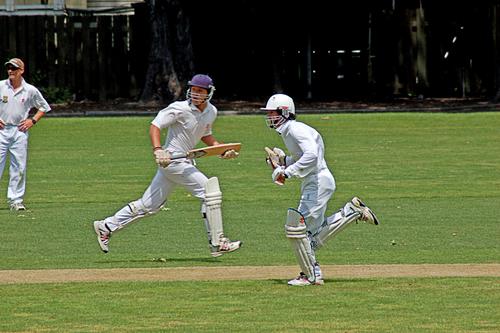Cricket movement: Run

Image credit: Shutterstock.com
In order to score a run, both batsmen have to run towards the opposite end and touch their bat on the crease. This constitutes a single run.
According to the Laws of Cricket, the simplest way for a batsman to score is by completing a run after a ball has been hit or a misthrow by the bowler or fielder occurs giving the batsmen an opportunity to rack up a run.
While there are no set amount of runs that can be completed, batsmen usually only continue running to and fro the popping creases until they are forced to stop by the fielding team or when the ball goes over the boundary.
If the ball goes over the boundary, then the batting team is automatically awarded four runs and if the ball leaves the boundary without first touching the field of play then six runs are awarded instead. Alternatively, both batsmen can choose not to run, if either or both of them deem the chances of completing a run to be low.
The proper way to execute a run is for the batsman to run from one popping crease to the other popping crease, with the other non-striking batsman running from the opposite crease. In order for the run to be registered, both batsmen have to put any part of their body or bat behind the line of the popping crease.
They will both have to run the length of the wicket simultaneously, crossing each other in the process and making sure that the fielding team does not catch them out. This situation happens when a batsman falls short of the popping crease when the bails of a stump are knocked off after being struck by the ball.
The runs carried out by the batsman will be added to the individual’s score, as well as the team’s score. However, if a run is awarded for extras such as no ball, the run is awarded only to the team score.
Runs are usually scored in even numbers, but odd number of runs are also possible. If an odd number of runs is scored, it means that the roles of both batsmen are reversed, and the non-striking batsman will be the next to bat.
In terms of milestones, a batsman scoring half a century (50 runs) or a century, hundred or ton (100 runs) are regarded as a significant achievement. As such, a partnership between two batsmen that adds to the aggregate team score in multiples of 50 runs is also deserves special applause. However, should a batsman be dismissed before being able to score a single run, then they would have deemed to have recorded a ‘duck’ or ‘duck’s egg’ and suffer the indignity of this failure.
Video credit: Sikana
To receive the latest updates on the happenings in the Singapore sports scene, or to find out more about some of the latest programmes on offer at ActiveSG, like our Facebook page here.





![ActiveSG Academies and Clubs Logo (Solid Colour)[8647]](https://www.activesgcircle.gov.sg/hs-fs/hubfs/ActiveSG%20Circle%202023Theme/images/ActiveSG%20Academies%20and%20Clubs%20Logo%20(Solid%20Colour)%5B8647%5D.png?width=150&height=65&name=ActiveSG%20Academies%20and%20Clubs%20Logo%20(Solid%20Colour)%5B8647%5D.png)



-01.png?width=200&height=141&name=Team%20Singapore%20Logo%20(Red)-01.png)



